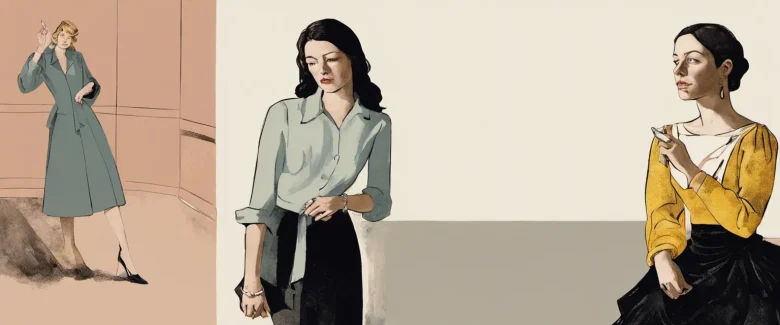In her illuminating book, “All the Single Ladies: Unmarried Women and the Rise of an Independent Nation,” Rebecca Traister delves into the transformative role of single women in shaping American society. Drawing on historical accounts, contemporary interviews, and personal narratives, Traister examines the various factors contributing to the remarkable surge in the number of unmarried women in recent decades. As an acclaimed journalist and author, Rebecca Traister has become a prominent voice on gender and politics in America. Through her insightful analysis and thought-provoking storytelling, she explores the social and cultural implications of this powerful demographic shift, challenging traditional expectations and redefining what it means to be single in our society.
Chapter 1: The Rise of Unmarried Women
Chapter 1: The Rise of Unmarried Women of the book “All the Single Ladies” by Rebecca Traister delves into the history and changing landscape of unmarried women in the United States. It explores how the societal expectations surrounding women’s lives and marriages have evolved over time.
Traister begins by discussing the rise of the suffragette movement in the late 19th and early 20th centuries, which laid the groundwork for women’s independence and their entry into the workforce. She highlights influential figures such as Susan B. Anthony and Elizabeth Cady Stanton, who challenged the traditional notion that a woman’s ultimate goal should be marriage and motherhood.
The author then shifts the focus to the post-World War II era, when marriage became highly prioritized, and women were encouraged to embrace domestic life. However, as the feminist movement gained momentum in the 1960s and 1970s, more women began to question these societal norms. They realized that marriage and motherhood were not the only paths to fulfillment and happiness. Increasingly, women chose to prioritize education, careers, and personal independence, leading to a decline in the average age of first marriage.
Traister also explores how race and socioeconomic factors intersect with the experiences of unmarried women. She emphasizes that the struggles and realities faced by unmarried women are not uniform but vary based on factors such as race, class, and education level. Through powerful anecdotes and statistics, the author showcases the growing number of unmarried women who are leading fulfilling lives by choice or circumstance.
Overall, Chapter 1 provides a comprehensive and thought-provoking overview of the historical context and changing attitudes towards unmarried women, laying the foundation for the exploration of single women’s lives in subsequent chapters.
Chapter 2: The Matrimonial Industrial Complex
Chapter 2 of “All the Single Ladies” by Rebecca Traister titled “The Matrimonial Industrial Complex” explores the transformation of marriage and its connection to women’s liberation and independence. Traister begins by discussing the historical context of marriage as a means of survival for women, where they relied on men for financial security and societal acceptance. However, the feminist movement of the 1960s and 1970s challenged these traditional gender roles and raised questions about the institution of marriage itself.
The chapter explores how the feminist movement coincided with the rise of no-fault divorce laws and the sexual revolution, which allowed women to assert their autonomy and empowered them to leave unfulfilling or abusive marriages. Traister argues that this newfound liberation disrupted the established social order, leading to a sense of anxiety and panic within society and a “backlash” against feminism.
Furthermore, Traister discusses the emergence of the “marital-industrial complex,” an industry built upon weddings and the commodification of marriage. This complex includes wedding planners, bridal magazines, and the multi-billion-dollar wedding industry that encourages couples to spend excessive amounts of money on their special day. Traister points out that this industry reinforces societal norms and pressures women to conform to idealized images of beauty and perfection.
Traister also delves into the commercialization of the diamond engagement ring, tracing its origins to a successful marketing campaign by De Beers that manipulated public perception and created an expectation for men to spend a significant portion of their income on this symbol of love.
In summary, Chapter 2 examines how the feminist movement has challenged the institution of marriage, leading to significant shifts in both societal expectations and the commercialization of weddings. Traister addresses the lingering anxiety surrounding changing gender dynamics and the ways in which the marital-industrial complex exploits these tensions for profit.
Chapter 3: Strange Bedfellows: Marriage and Politics
Chapter 3 of “All the Single Ladies” by Rebecca Traister, titled “Strange Bedfellows: Marriage and Politics,” delves into the complex relationship between marriage and women’s political and societal progress.
Traister examines how marriage, historically considered a bedrock institution, affected women’s lives and limited their options. She highlights that until recently, marriage was often deemed essential for women’s financial security and social standing, leaving many single women marginalized when it came to power and decision-making. However, she also acknowledges that marriage has brought significant changes for women, particularly in terms of economic empowerment and the ability to challenge societal norms.
The chapter explores the changing attitudes towards marriage, with Traister asserting that as more women have gained economic independence and access to education, marriage has become less of a necessity. The ability to remain single has allowed women to focus on personal and professional growth, leading to advancements in women’s rights and gender equality. Traister argues that single women are instrumental in pushing for policy changes, as they often have a greater stake in societal reforms, such as better childcare, healthcare, and equal pay.
Furthermore, the chapter discusses the rise in the political power of single women, highlighting that they have become a significant voting bloc. Traister points out that, contrary to stereotypes, single women are politically engaged and act as catalysts for progressive change. Their influence has been evident in consequential election results and policy shifts.
In conclusion, Chapter 3 of “All the Single Ladies” emphasizes how marriage has historically influenced women’s lives, but also demonstrates the changing dynamics and the growing agency of single women in shaping society and politics. Single women have played a vital role in challenging traditional norms, advocating for gender equality, and advancing progressive policies.
Chapter 4: The Sexual Double Standard

Chapter 4 of “All the Single Ladies” by Rebecca Traister explores the sexual double standard that exists in society. The chapter delves into how women’s sexuality has been defined and controlled, while men often face fewer consequences for their sexual behavior.
Traister begins by discussing historical attitudes towards female sexuality, highlighting societal expectations that women be pure and virtuous. She emphasizes how these standards have limited women’s sexual freedom and expression, often leading to shame and judgment. On the other hand, men have been given more leeway and even praised for their sexual pursuits.
The chapter also examines the impact of birth control and the sexual revolution on women’s lives. While these developments allowed for more sexual freedom, they did not entirely eradicate the double standard. Traister explores how women’s sexuality continued to be policed and how societal judgments persisted.
Traister goes on to discuss the modern era, where advancements in technology, such as dating apps and social media, have facilitated casual sex and hook-up culture. However, she notes that despite these changes, women still face pressures and consequences that men do not. Women are often stigmatized for engaging in casual sex or labeled as “sluts,” while men are celebrated for their sexual conquests.
In conclusion, Chapter 4 highlights the ongoing existence of a sexual double standard, wherein women’s sexuality is judged and controlled more harshly than men’s. Traister argues that society needs to challenge these norms and promote sexual autonomy and equality for all.
Chapter 5: The “All-Consuming” Nature of Caretaking
Chapter 5 of “All the Single Ladies” by Rebecca Traister delves into the “all-consuming” nature of caretaking and its impact on women’s lives. The chapter explores the societal expectations placed on women to prioritize caregiving roles, often at the expense of their own dreams, aspirations, and personal freedom.
Traister begins by examining the history of caregiving expectations, harkening back to the 19th and early 20th centuries when women were expected to devote their lives to home and family. She discusses the idea of “the angel in the house,” a stereotype that confined women to the domestic realm, perpetuating the belief that their worth was rooted solely in their ability to care for others.
The author highlights the ways in which modern women continue to be burdened by these expectations. She explores the various caretaking roles women often find themselves in, including providing emotional support, raising children, caring for aging parents, and navigating the world of household management. These responsibilities, Traister argues, consume women’s time, energy, and resources, often limiting their ability to pursue careers, hobbies, or personal fulfillment.
Furthermore, Traister introduces the concept of the “caring penalty.” Women who take on caregiving responsibilities are frequently penalized in the workforce, facing reduced wages, decreased opportunities, and limited advancement. This penalty reinforces the notion that women’s primary purpose is caretaking and positions their work as secondary.
Overall, Chapter 5 depicts the unbalanced nature of caregiving expectations and the toll it takes on women’s lives. Traister highlights the need for society to reassess and redistribute caregiving responsibilities to create a more equitable and fulfilling future for women.
Chapter 6: Independence, Friendship, and Community
Chapter 6 of “All the Single Ladies” by Rebecca Traister explores the themes of independence, friendship, and community. This chapter focuses on the importance of connections and relationships among single women and the powerful networks they create.
Traister begins by discussing the history of women living alone and the societal stigmas they faced in the past. However, she highlights the fact that single women today are increasingly choosing autonomy and independence as they prioritize their careers, personal growth, and personal fulfillment over traditional expectations of marriage and family.
Friendships, particularly among single women, play a crucial role in their lives. Traister emphasizes the deep and meaningful bonds women form with each other, often providing the emotional support and sense of belonging that society once expected from marriage. These friendships offer companionship, shared experiences, and a support network that helps women navigate the challenges of life.
Furthermore, Traister explores the concept of chosen families, where unmarried women create close-knit communities with their friends as a substitute for conventional familial structures. These chosen families provide a sense of belonging, love, and support that traditional families may lack.
The chapter also highlights the importance of community involvement for single women. Being unburdened by familial responsibilities, single women have more time and energy to invest in their communities. They often engage in activism, volunteer work, and mentorship, contributing positively to society.
Overall, Chapter 6 depicts the rich and interconnected lives of single women. It demonstrates that choosing independence and forging meaningful friendships and communities lead to fulfilling and empowered lives for many women who have embraced the single life.
Chapter 7: The Economic Power of Single Women
Chapter 7 of “All the Single Ladies” by Rebecca Traister, titled “The Economic Power of Single Women,” explores how single women have become an influential force in the economy and are reshaping society.
Traister begins the chapter by highlighting the demographic shifts that have led to the rise of single women’s economic power. Marriage rates have decreased, divorce rates have risen, and women are delaying marriage or opting to remain single altogether. With more women choosing to prioritize their careers, education, and personal goals over marriage, they are more financially independent than ever before.
The author discusses how single women contribute significantly to the workforce, making up a significant percentage of professionals, entrepreneurs, and business owners. They often have higher levels of education, which results in higher salaries and greater economic mobility. Single women can focus on their careers without the constraints of marriage or family responsibilities, allowing them to accumulate wealth and assert financial independence.
Furthermore, Traister explores the purchasing power of single women. They are a lucrative consumer group, often making their own financial decisions, buying homes, and engaging in leisure activities, contributing significantly to the economy. This economic power gives single women leverage and influence in various industries, with businesses catering to their specific needs and desires.
However, Traister also highlights the challenges faced by single women, such as the gender wage gap and discrimination in the workplace. Despite their economic achievements, single women still face societal pressures and stigmatization, often being labeled as unhappy or incomplete without a partner.
In summary, Chapter 7 of “All the Single Ladies” examines how single women are reshaping the economy with their rising economic power. They are successful professionals, entrepreneurs, and consumers, driving change in society and influencing industries. However, they also face obstacles and biases that need to be addressed to ensure equal opportunities and recognition.

Chapter 8: Changing the Narrative: The Future of Unmarried Women
In Chapter 8 of “All the Single Ladies” by Rebecca Traister, titled “Changing the Narrative: The Future of Unmarried Women,” Traister explores the evolving cultural shifts surrounding unmarried women and challenges traditional social expectations placed upon them.
Traister begins by examining how the social and economic conditions in America have drastically transformed over the past century, leading to a significant rise in the number of unmarried women. Historically, unmarried women were often seen as incomplete or lacking fulfillment, but Traister argues that these perceptions are gradually changing as single women today lead rich, fulfilling lives independent of marriage.
The author delves into various narratives of unmarried women and the positive aspects of their lives. She highlights the growing recognition of single women’s autonomy and the empowerment that comes with it. Traister explores how many women view being single not as a temporary limbo, but as a conscious choice representing independence, freedom, and personal growth.
Moreover, Traister discusses the emergence of the “Female Lifestyle Empowerment Brand” and the powerful influence it has on single women. This brand highlights successful single women who have built fulfilling lives without conforming to societal expectations. Traister explains how this shift in narrative helps challenge the notion that a woman’s worth is solely tied to her marital status.
Throughout the chapter, Traister emphasizes the importance of recognizing and appreciating the lives and experiences of unmarried women, highlighting their contributions to society and advocating for a more inclusive narrative. By shedding light on the narratives and lived experiences of single women, she reinforces the significance of their voices in shaping the future and dismantling outdated societal norms.
After Reading
In conclusion, Rebecca Traister’s book “All the Single Ladies” explores the changing trends and implications of unmarried women in contemporary society. Through various personal narratives, historical analysis, and cultural insights, Traister highlights the diverse experiences and significant contributions of single women throughout history. She challenges society’s traditional expectations and stereotypes surrounding marriage and offers a powerful argument for embracing and celebrating women’s independence. Ultimately, “All the Single Ladies” sheds light on the growing influence and empowerment of single women, encouraging readers to reimagine the possibilities and potential of being unattached in a world that often prioritizes coupled relationships.
1. “Dreamland” by Sam Quinones: The book takes readers on a comprehensive journey, tracing the roots of the opioid epidemic from various angles. Quinones explores the convergence of factors that contributed to the crisis, including the over-prescription of pain medications, the aggressive marketing tactics employed by pharmaceutical companies, and the subsequent proliferation of black-market heroin.Through extensive research and interviews, Quinones paints a vivid picture of the impact of opioids on different communities, highlighting the stories of those affected by addiction, drug trafficking, and the associated violence. He also sheds light on the emergence of “pill mills” and the role of Mexican drug cartels in supplying cheap, potent heroin to American markets.
2. “The Death of Expertise” by Thomas M. Nichols: Nichols argues that in today’s information age, where access to knowledge is readily available, there has been a shift towards a culture of anti-intellectualism and skepticism towards experts. He discusses the consequences of this trend, highlighting how it leads to a devaluation of expertise and undermines the foundations of informed decision-making.The book examines various factors contributing to the erosion of expertise, including the rise of social media, the democratization of knowledge through the internet, and the rejection of evidence-based reasoning. Nichols emphasizes the importance of recognizing the limits of one’s own knowledge and the need to defer to those with specialized expertise.
3. Ikigai” by Héctor García, Francesc Miralles: The authors delve into the secrets of longevity and well-being observed in the Japanese island of Okinawa, where people live exceptionally long and healthy lives. They examine the factors that contribute to the residents’ sense of ikigai and discuss how individuals can uncover their own purpose and meaning.”Ikigai” presents a framework that combines four elements: what we love, what we are good at, what the world needs, and what we can be paid for. It suggests that true fulfillment and happiness can be found at the intersection of these four aspects. The book encourages readers to reflect on their passions, talents, values, and the needs of the world around them to discover their own ikigai.
4. “Men Explain Things to Me” by Rebecca Solnit: With wit and insight, Rebecca Solnit addresses the issue of mansplaining and explores the broader implications of gender inequality. Solnit’s collection of essays dissects the dynamics of patriarchy and highlights the importance of amplifying women’s voices and experiences.
5. “The Vagina Monologues” by Eve Ensler: A powerful and provocative play, “The Vagina Monologues” consists of a series of fictional stories and real-life accounts about women’s experiences with sex, love, and self-discovery. Through candid and honest narratives, Eve Ensler demonstrates the diversity and complexity of women’s experiences, challenging societal taboos and raising awareness about the importance of gender equality.



